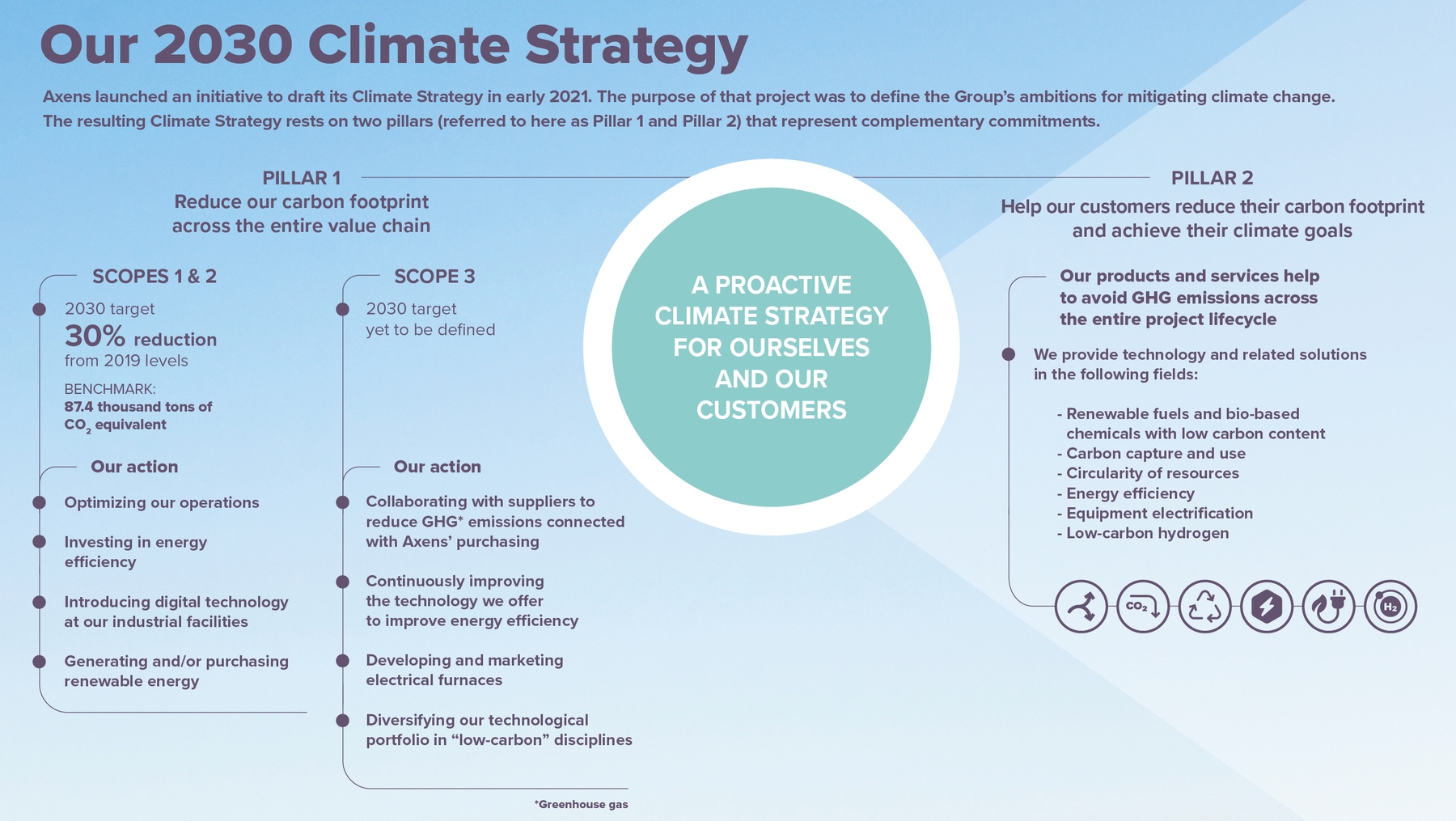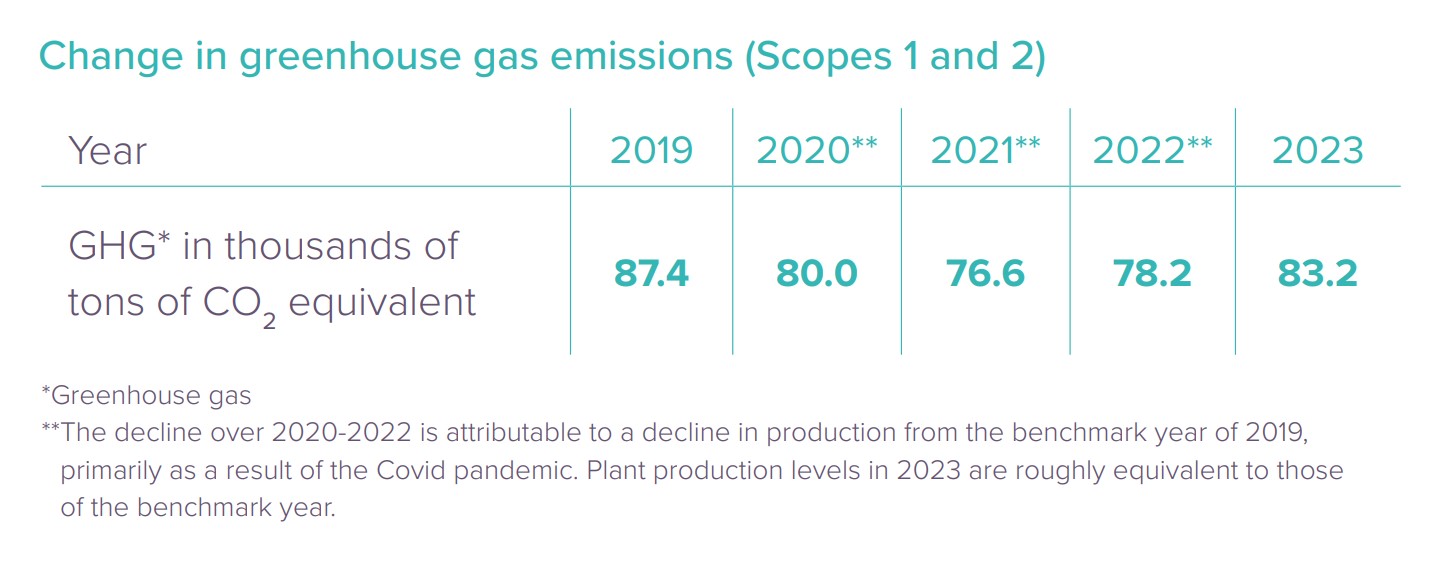Axens Climate Strategy, based on two pillars, has been defined to contribute to collectively reduce GHG emissions.
- Reducing Axens carbon footprint with targets regarding the reduction of absolute GHG emissions by 2030.
- Helping clients in their decarbonization journey, in reducing their corporate footprint. This means that Axens will strive to decarbonize its ecosystem beyond the scope of its own carbon footprint thanks to the deployment of Axens technologies and solutions. Axens commits to fully leverage its skills and expertise to reduce GHG emissions within and beyond its value chain, to bring and increase « avoided emissions » .

Pillar 1: Reducing our own emissions
Pillar 1 of the Axens Climate Strategy involves shrinking the Group’s carbon footprint. That entails a variety of measures and initiatives to reduce greenhouse gas (GHG) emissions directly or indirectly tied to Axens’ business operations—i.e. those included in Scopes 1, 2 and 3 of the GHG Protocol Corporate Standard.
Reducing Scope 1 and 2 emissions by 30% in absolute terms
Although the Group is not eligible for the Science Based Targets Initiative (SBTi), given the share of its revenue derived from the oil and gas industry, it has nonetheless chosen to align its 2030 Scope 1+2 GHG emissions reduction targets with the pathway for capping the rise in global warming at Well Below 2 Degrees (WB2D) by the end of the century.
Accordingly, the Group intends to curb Scope 1+2 emissions by 30% in absolute terms.

A diminishing carbon footprint at Salindres
Our Salindres plant in southern France, which specializes in the manufacture of adsorbents and catalysts, is adhering to the Group’s roadmap by adopting the target of reducing Scope 1 and 2 greenhouse gas emissions by 30% between now and 2030. Most of those emissions come from combustion of the natural gas used to supply process heat and generate steam.
The ISO 50001 certified plant has adopted two complementary strategies for meeting that decarbonization target: improving energy conservation and transitioning to zero-carbon energy sources. The hunt for greater efficiency is reflected in a campaign initiated in 2015 to reduce the plant’s energy use.
Assessing Scope 3 emissions
Axens has been calculating its Scope 3 greenhouse gas emissions (i.e. indirect emissions connected with all activities upstream and downstream from Axens sites) for all categories except category 11. For this category 11 dedicated to the use of sold products, calculations are on-going. Once completed, the Group will announce a Scope 3 emissions reduction target for 2030.
Measuring our product’s carbon footprint
Just over a year ago, Axens pledged to assess the carbon footprint of some representative products from its portfolio of catalysts and adsorbents. That undertaking, conducted in accordance with the ISO 14040, 14044 and 14067 standards, drew on a cradle-to-gate basis. The project is designed to help the Group fulfill two major aspirations: ability to measure the carbon footprint of many different products in response to customer requests, and identify potential measures for decreasing that footprint.
Pillar 2: Helping our customers cut their emissions and achieve their climate goals
As part of the second pillar of its Climate Strategy, Axens plans to help its customers shrink their carbon footprint and thereby fulfill their own climate objectives.
Fruitful solutions
Axens is unique in that it offers a very wide range of technological solutions with positive benefits for its customers and their carbon footprint. Working in conjunction with its parent company, IFP Energies nouvelles (IFPEN), and other partners, the Group has designed and developed solutions for converting biomass into renewable fuels or biosourced chemicals, producing low-carbon hydrogen, recycling used plastics, capturing CO2 and much more.
Calculating the GHG emissions avoided
Axens has a variety of solutions in its portfolio (licensed processes, equipment, catalysts and adsorbents, etc.) that can help avoid GHG emissions on the whole life cycle of the projects on which they are implemented.
The Group has not assessed avoided emissions on an exhaustive basis but has started by doing so on a selection of projects for which Axens has been selected as process licensor in 2022.
Assuming that all these projects reach completion, total associated avoided emissions amounts to 33.7 million tons of CO2 equivalent, thanks to all project stakeholders.
